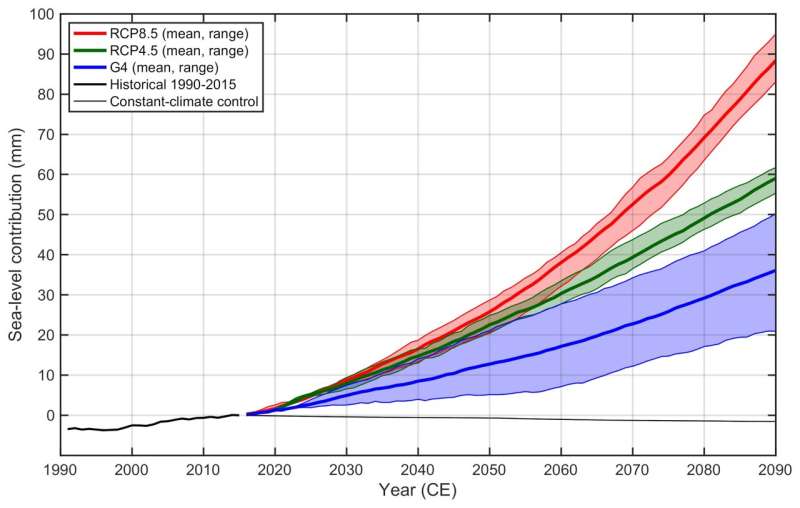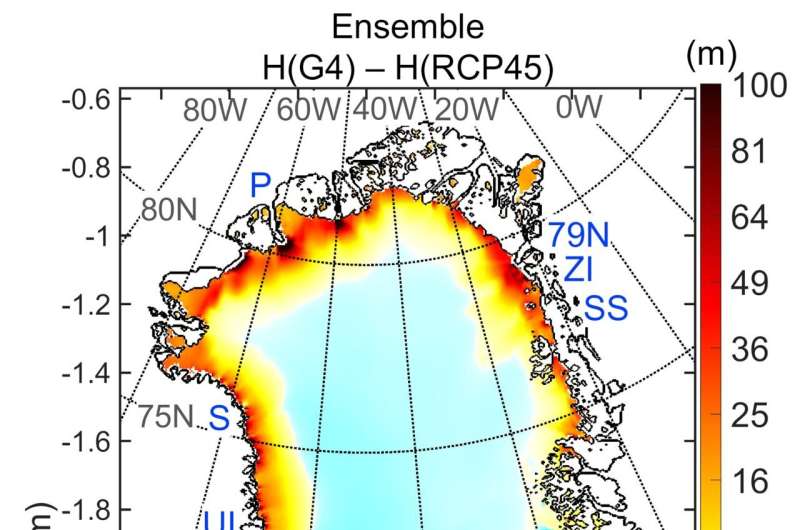This article has been reviewed according to Science X's editorial process and policies. Editors have highlighted the following attributes while ensuring the content's credibility:
fact-checked
trusted source
proofread
Geoengineering may slow Greenland ice sheet loss, finds modeling study

One of the many effects of global warming is sea-level rise due to the melting and retreat of the Earth's ice sheets and glaciers. As the sea level rises, large areas of densely populated coastal land could ultimately become uninhabitable without extensive coastal modification. In order to stave off this possibility, carbon emissions need to reach net negative, a state that is hard to achieve under current circumstances.
There are many proposals to drastically mitigate the effects of climate change, and the most expansive of these involve interventions that will alter aspects of the entire globe—geoengineering techniques. While they have some promise, we do not understand enough about natural cycles to fully assess how beneficial such interventions will be.
An international team of researchers led by Professor John C. Moore, at the University of Lapland, Rovaniemi, Finland, and Professor Ralf Greve, at the Institute of Low Temperature Sciences, Hokkaido University, has used simulations to examine the potential effects of a geoengineering technique called stratospheric aerosol injection on ice sheet melting. Their findings were published in the Journal of Geophysical Research: Earth Surface.
"Stratospheric aerosol injection, or SAI, would artificially introduce aerosols into the stratosphere by aircraft or high-altitude balloons to create a cooling effect via global dimming and increased albedo—the degree to which Earth reflects sunlight," Moore explains.

Moore, Greve and colleagues used the SICOPOLIS model to simulate the changes in the Greenland Ice Sheet for the period 1990–2090 under three different scenarios: RCP8.5 (worst-case scenario, unabated warming); RCP4.5 (intermediate scenario, possibly achievable under current conditions); and GeoMIP G4 (RCP4.5 plus the injection of 5 million metric tons of sulfur dioxide per year into the stratosphere during 2020–2070).
The simulations showed that SAI of sulfur dioxide would have a clear protective effect on the Greenland Ice Sheet. Under RCP8.5, there would be ice loss equivalent to approximately 90 mm sea-level rise; under RCP4.5, ice loss would be approximately 60.6 mm sea-level rise; but under GeoMIP G4, ice loss would be limited to approximately just 37.6 mm sea-level rise. When these scenarios were tested with a different model, Elmer/Ice, the results were similar. The margins of the ice sheet would benefit the most under GeoMIP G4.
"While this study shows that SAI could contribute to the protection of the Greenland Ice Sheet, and hence, potentially, all other ice cover on Earth, geoengineering is a highly contentious topic," Greve concludes. "The biggest issue is that it addresses only the symptoms of global warming, not the root causes—and may even delay the changes required to address the causes. Furthermore, due to the immense complexity of the natural systems on Earth, it is impossible to predict exactly what positive and negative outcomes could result."
More information: John C. Moore et al, Reduced Ice Loss From Greenland Under Stratospheric Aerosol Injection, Journal of Geophysical Research: Earth Surface (2023). DOI: 10.1029/2023JF007112
Provided by Hokkaido University




















